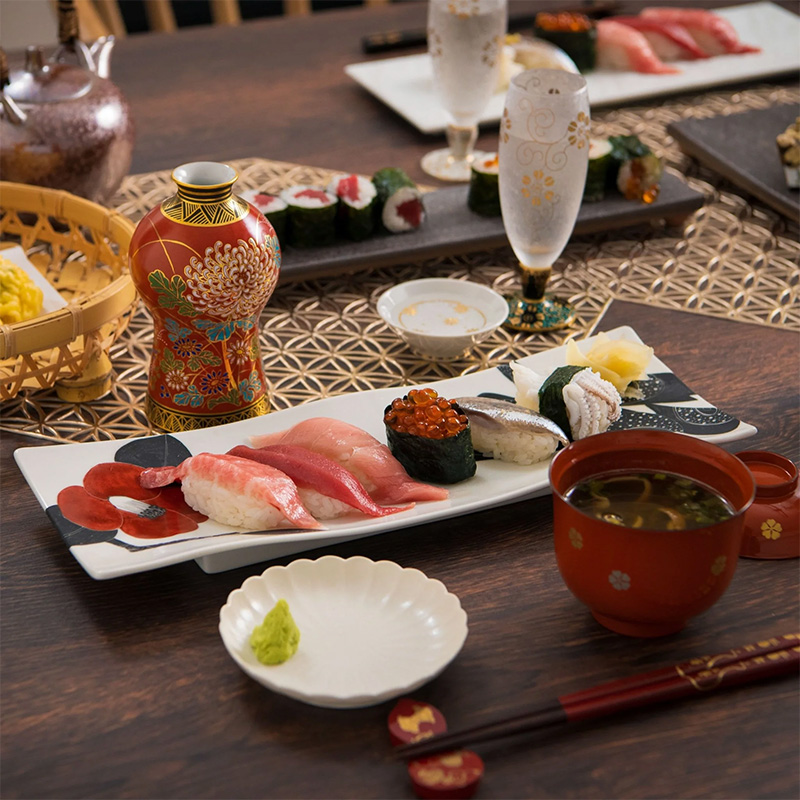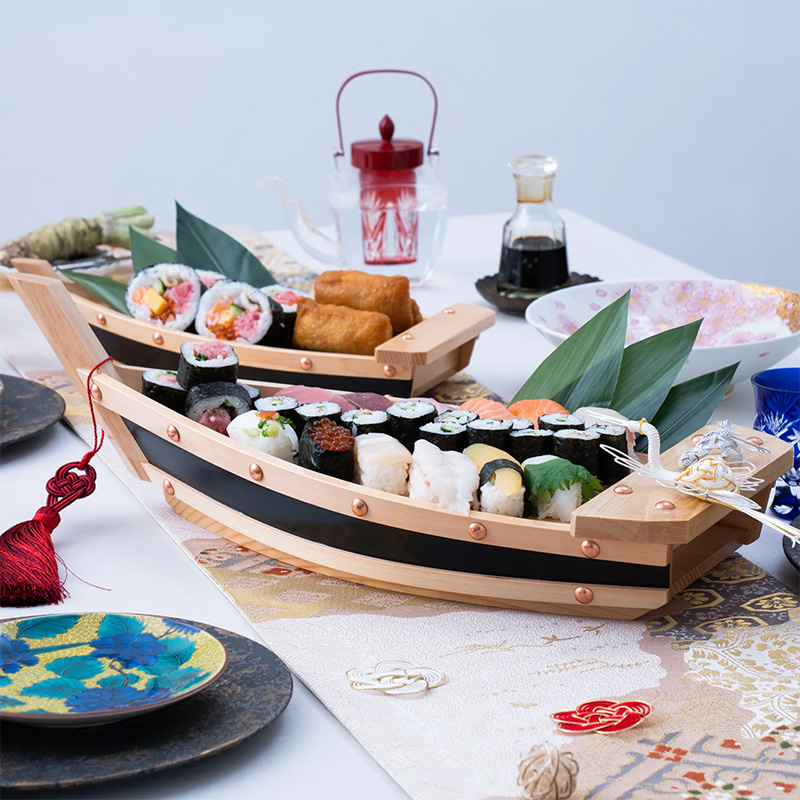Sushi Plates: An Artful Touch to Japanese Cuisine
Understanding Sushi Plates
Sushi plates, a fundamental aspect of the sushi experience, serve as a bridge between the culinary art of sushi and its presentation. These plates are not merely functional items; they are a part of the aesthetic appeal, enhancing the visual and sensory experience of sushi dining. The choice of plate can influence the perception of sushi, making it a crucial element for sushi chefs and enthusiasts alike.

The History and Evolution of Sushi Plates
The journey of sushi plates through history is as rich and varied as the history of sushi itself. Originating from simple wooden planks to today's elegant ceramic and glass creations, sushi plates have undergone a remarkable transformation. This evolution reflects the changes in sushi preparation and presentation over the centuries, showcasing the adaptability and innovation in Japanese cuisine.
>>> Explore more: Conveyor Belt Sushi: A Unique Japanese Dining Journey
Types of Sushi Plates and Their Uses
Sushi plates come in various forms, each designed for specific types of sushi. The classic rectangular plate, for instance, is perfect for nigiri or sashimi, allowing each piece to be displayed distinctly. On the other hand, small round plates are ideal for single sushi rolls, highlighting their intricate construction. Understanding these types helps in choosing the right plate for each sushi style.
Materials Used in Sushi Plates
The material of a sushi plate can greatly influence the dining experience. Traditional ceramics, often adorned with intricate Japanese motifs, offer a classic and authentic feel. Contemporary materials like glass or bamboo add a modern twist, aligning with current dining trends while still respecting the sushi's roots.
Design and Aesthetics of Sushi Plates
The design of a sushi plate is a crucial element in sushi presentation. A well-designed plate complements the sushi's colors and textures, enhancing its natural beauty. The aesthetic appeal of sushi plates is not merely about looks; it's about creating a harmonious balance between the dish and its presentation.

The Importance of Size and Shape in Sushi Plates
The size and shape of a sushi plate are key in determining how sushi is presented. A plate too large can make the sushi look sparse and uninviting, while a too-small plate can appear cluttered. The shape, whether round, square, or rectangular, should complement the type of sushi being served.
Cultural Significance of Sushi Plates
Sushi plates are deeply rooted in Japanese culture. Their designs often reflect traditional Japanese aesthetics, such as minimalism and the celebration of natural beauty. This cultural significance adds depth to the sushi dining experience, making it a journey through Japanese art and tradition.
Sushi Plates in Modern Dining
In modern dining settings, sushi plates reflect a blend of traditional and contemporary design. They mirror the evolution of sushi from a traditional Japanese dish to a global culinary phenomenon, adapting to various dining environments while maintaining their cultural essence.
Choosing the Right Sushi Plate
Choosing the right sushi plate involves a consideration of the sushi type, the dining ambiance, and personal preference. For a traditional sushi experience, a classic ceramic plate might be ideal. For a more contemporary setting, a plate with modern design elements could be more appropriate.
Custom Sushi Plates
Custom sushi plates allow for personalization in the dining experience. These plates can be tailored to reflect a chef's culinary style or to commemorate a special event. Custom plates add a unique touch to sushi dining, making the experience more personal and memorable.

Sushi Plates for Special Occasions
For special occasions, selecting the right sushi plate becomes even more important. Whether it's a family gathering, a romantic dinner, or a formal event, the sushi plate can set the tone for the occasion. Elegant and understated designs can add sophistication, while bold and artistic plates can create a festive atmosphere.
>>> Read more: Japanese Cuisine: A Journey Through Flavor & Tradition
Maintaining and Caring for Sushi Plates
Maintaining sushi plates is essential to preserve their beauty and functionality. This involves proper cleaning, storage, and handling, especially for delicate materials like ceramic or glass. Taking care of sushi plates ensures they remain a cherished part of the dining experience for years to come.
Where to Buy Quality Sushi Plates
Finding quality sushi plates is crucial for any sushi enthusiast. This section will guide readers on where to find plates that are not only aesthetically pleasing but also durable and functional. Whether it's visiting traditional Japanese stores, exploring online marketplaces, or seeking out specialty shops, there are many options for purchasing sushi plates.
Sushi Plates as Collectibles
For some, sushi plates are more than just dining accessories; they are collectibles. These individuals appreciate the artistry and history behind each plate, often seeking rare or handcrafted pieces. Collecting sushi plates becomes a hobby that complements their love for sushi and Japanese culture.
Sushi Plates and Sustainability
With sustainability becoming increasingly important, this section explores eco-friendly options in sushi plates. From materials to manufacturing processes, there are ways to enjoy sushi while being mindful of the environment. Sustainable sushi plates are not just a trend; they are a step towards a more responsible culinary practice.
Conclusion: The Role of Sushi Plates in the Culinary World
Sushitrain plates play a crucial role in the culinary world, particularly in the realm of Japanese cuisine. They are not just functional items; they are an integral part of the sushi experience, blending art, tradition, and gastronomy. The right sushi plate can elevate a simple dish into a memorable culinary journey, making it an indispensable element for any sushi lover.
FAQs About Sushi Plates
What materials are commonly used in making sushi plates?
Sushi plates are typically made from ceramics, glass, wood, or bamboo, each offering a unique aesthetic and dining experience.
How do I choose the right sushi plate for my needs?
Consider the type of sushi you're serving, the dining setting, and your personal style preferences. For traditional sushi, ceramic plates are a classic choice, while modern designs might suit contemporary settings better.
Can I use sushi plates for other types of food?
Yes, sushi plates are versatile and can be used for a variety of dishes, though their design is specifically suited for presenting sushi.
Are custom sushi plates available?
Yes, custom sushi plates can be made to reflect personal styles or commemorate special occasions.
How should I care for my sushi plates?
Proper care includes gentle washing, avoiding harsh chemicals, and proper storage to prevent chips or cracks, especially for ceramic and glass plates.
RESTAURANT LOCATIONS
-
 94 White Bridge Rd Nashville, TN 37205 Hotline: (615) 353-8000
94 White Bridge Rd Nashville, TN 37205 Hotline: (615) 353-8000




